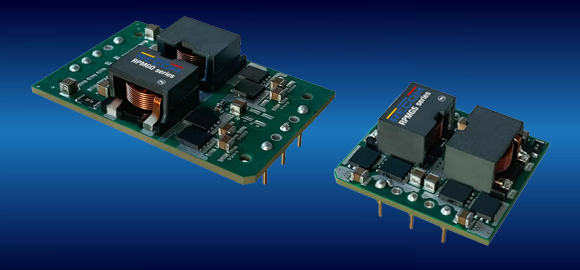At the Point of Load
High-efficiency point-of-load DC/DC converters for energy applications
Power Supplies I 26.09.2024
Growing demands on efficiency, thermal management and transient response have led to improvements in power supply architecture. Key components of these recent advances are highly efficient PoL DC/DC converters.

Figure 1: New point-of-load DC/DC converter families from RECOM (Source: RECOM)
The job of a power supply is to provide and distribute electrical energy to electrical devices or systems. It ensures that the voltage and current supplied to connected loads are within certain tolerances. This is achieved by converting an input voltage (AC/DC) into one or more outputs at a lower voltage (DC) as efficiently as possible. A typical design starts with an AC/DC converter utilising power factor correction (PFC) to maximise the power available from the AC grid and to meet the various power factor regulatory requirements.
Centralised Power Architecture (CPA) is effective when voltages are high and currents are low, or when the distances between the power supply and connected loads are short. However, many contemporary applications are based on digital devices such as microprocessors, memory modules, digital signal processors, or application-specific integrated circuits with small geometries, calling for multiple low voltages with high currents.
The design of DC/DC modules has evolved from the bulky and often inefficient CPA to compact and efficient Distributed Power Architecture (DPA) and Intermediate Bus Architecture (IBA). Both aim to minimise the power lost, mainly as heat, when electricity is transmitted via a resistive connection – a wire, busbar or printed circuit board.
This is where point-of-load DC/DC converters (PoL converters) come into play. These are special DC/DC converters that regulate the voltage directly at the point of consumption (i.e. at the load), minimising voltage losses caused by long leads or cables and ensuring high efficiency.
PoL converters are of particularly interest for energy systems as they can react quickly to load changes – especially important in systems with highly fluctuating loads. In this regard, PoL DC/DC converters score highly on several fronts:
• Increased efficiency: Because voltage regulation takes place directly at the point of demand, losses due to long transmission paths are minimised, increasing the overall efficiency of the energy system.
• Better power quality: The proximity to the load ensures a more stable and precise power supply, improving the performance and service life of connected devices.
• Flexibility and scalability: PoL converters enable straightforward scalability and adaptation to different load requirements.
• Fast response time: PoL converters can be integrated easily into smart energy management systems that are able to react dynamically to load changes and energy requirements.
• Cost efficiency: Reducing power losses and improving efficiency results in lower operating costs. In addition, the compact design saves space and thus the associated costs.
Products and examples
With their RPMGQ-20 and the RPMGS-20 series, RECOM now offers two new series of cost-effective, high-efficiency DC/DC converters that are particularly suitable for 24V, 28V and 48V power supply buses as a PoL solution in a DPA. These through-contacted, non-isolated DC/DC step-down converters provide output power of 20A as well as other features:
• Space-saving design: The RPMGQ-20 comes in the industry-standard quarter-brick format, and the RPMGS-20 in the emerging 36.83 mm x 34.04 mm (1.45" x 1.34") housing with standard sixteenth-brick pin-out. Both products have a maximum height of 15mm from their mounting surface, facilitating integration into a range of systems.
• Flexible and scalable: The converters operate on input voltage of 18V to 75V, with either 5V or 12V output, trimmable over a wide range from 3.3V to 8V or 8V to 24V.
• High efficiency: The RPMGQ-20 and RPMGS-20 devices offer excellent efficiency, peaking at 98% for the 12V output versions and 94% for the 5V versions, with the efficiency curve remaining almost flat down to a load of approx. 10%.
• Extended application possibilities: With low losses and advanced thermal design, all versions can be operated up to an ambient temperature of over 90°C at full load, and up to 120°C with derating.
• Advanced protection functions: To increase the reliability and service life of the system, the units offer comprehensive protection against input undervoltage, output overcurrent, short circuit and overtemperature.
• Low residual ripple: The converters offer low output ripple – particularly important for sensitive electronics.
With their efficiency, flexibility and the option of direct voltage regulation, the two new series are particularly suitable for use in modern, complex energy systems. In data centres, they ensure that the various processors, memory, and network devices have an efficient, stable voltage supply. In telecommunications systems, PoL converters ensure a reliable power supply for sensitive electronics and help improve overall system stability. In industrial applications, they improve the energy efficiency and quality of performance of control systems and machines. In solar and other renewable energy systems, the converters help to use energy efficiently and keep losses to a minimum.
At Schukat
Schukat electronic offers power supplies from RECOM and other manufacturers. Schukat stocks around 6000 different types of power supplies and DC/DC converters in production quantities at its automated central warehouse in Monheim am Rhein, Germany.
The distributor also provides fast, competent support with direct contact persons, and also offer an expert field service team for on-site problem solving. Customers benefit from rapid processing of enquiries, availability of data sheets and samples, and variable delivery quantities – from samples to series production.
